Rotterdam's history in a nutshell
The beginning (until 1360)
Already around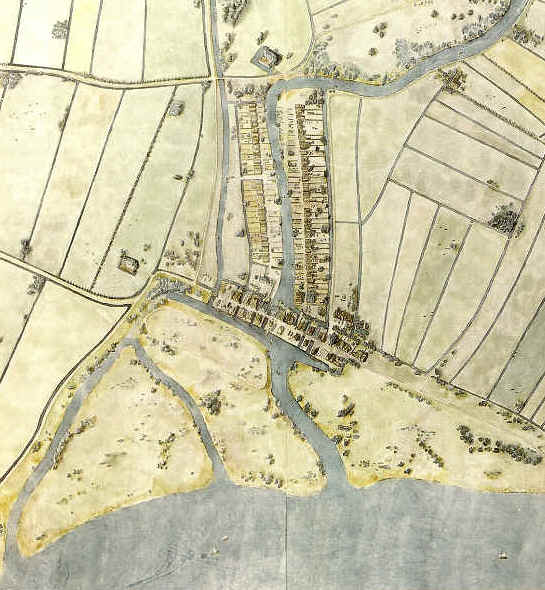 900 AD there were settlements in the area around the Rotte estuary.
The area was part of the county of Holland, which in turn was part
of the Holy Roman (German) Empire. The Count of Holland had granted
territories in fief to vassals, who exercised their authority
locally. The fiefdoms became hereditary. West of the River Rotte the
Lords of Bokel had their territory, the East belonged to the
Voorschoten family. Other fiefdoms were Cralinghen, Mathenesse and
Spangen. The nobles had each made there own protective walls against
the frequent floods. Count Floris V (1256-96) ordered the Lords to
connect there individual dykes in order to construct one single sea
wall against the floods. This sea wall cut off the Rotte from the
River Maas. This part of the wall was called Middendam (Middle Dam;
now Hoogstraat). Around this dam Rotterdam developed. In the decades
after that the settlers around the Middendam gained privileges from
the Counts of Holland. In 1340 Count Willem IV granted a city
charter to the areas East and West of the River Rotte. The city was
also allowed to dig a canal to the River Schie (Rotterdamse Schie)
to establish a connection with the Dutch hinterland (Delft, Leiden,
Haarlem). In 1358 Rotterdam got permission to build city walls.
900 AD there were settlements in the area around the Rotte estuary.
The area was part of the county of Holland, which in turn was part
of the Holy Roman (German) Empire. The Count of Holland had granted
territories in fief to vassals, who exercised their authority
locally. The fiefdoms became hereditary. West of the River Rotte the
Lords of Bokel had their territory, the East belonged to the
Voorschoten family. Other fiefdoms were Cralinghen, Mathenesse and
Spangen. The nobles had each made there own protective walls against
the frequent floods. Count Floris V (1256-96) ordered the Lords to
connect there individual dykes in order to construct one single sea
wall against the floods. This sea wall cut off the Rotte from the
River Maas. This part of the wall was called Middendam (Middle Dam;
now Hoogstraat). Around this dam Rotterdam developed. In the decades
after that the settlers around the Middendam gained privileges from
the Counts of Holland. In 1340 Count Willem IV granted a city
charter to the areas East and West of the River Rotte. The city was
also allowed to dig a canal to the River Schie (Rotterdamse Schie)
to establish a connection with the Dutch hinterland (Delft, Leiden,
Haarlem). In 1358 Rotterdam got permission to build city walls.
Hoeken and Kabeljauwen (1345 - 1490)
After Count Willem IV's death a power battle broke out between Willem's sister Margaretha and her son Willem V. In this struggle the nobility and the cities took sides (although many frequently changed sides along the way) on the basis of old feuds and differences of interest. The two parties are called Hoeken (Hooks) and Kabeljauwen (Cods) respectively. Rotterdam tried to stay outside the troubles as much as possible in order to gain a better position than its competitors. The Rotterdam economy, in those days, was mainly based on herring fisheries and handling of cargo on the Rivers Rotte and Schie. Around 1490 Rotterdam could no longer avoid the hostilities, when Squire Frans van Brederode chose Rotterdam as his base for his Hook army. Squire Frans was beaten by Burgundy, which was the end of the troubles.
Eighty year War (1568-1648)
Rotterdam emerged reasonably well from the
struggle. It managed to get Dordrecht's trade monopolies abolished. In
1572 Rotterdam became in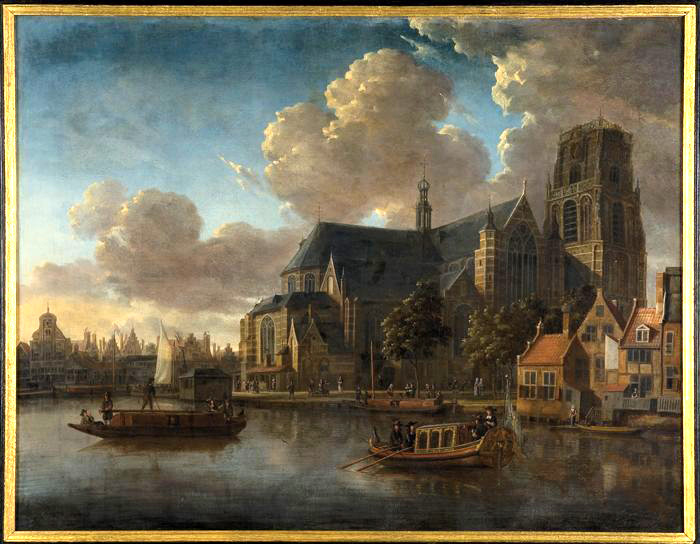 volved
in the Eighty Year War between the Low Countries and Spain. The
Spanish King Philip II, who had inherited the title of Lord of the Low
Countries from his father Charles V, tried to enforce absolute rule in
these countries who had until then enjoyed many priviliges and
relative autonomy. The emerging conflict was intensified by the fact
that the Church Reformers became increasingly popular in the Low
Countries. Philip II, as an absolute Roman Catholic ruler could not
tolerate these heresies. In 1572 a rebel army conquered the town of
Den Briel and the Spanish forces led by general Boussu were chased
away in a southerly direction. The rebels took advantage of the vacuum
left behind and took Delfshaven. The next thing was a march on
Rotterdam. The city fended off the attack, but a few days
volved
in the Eighty Year War between the Low Countries and Spain. The
Spanish King Philip II, who had inherited the title of Lord of the Low
Countries from his father Charles V, tried to enforce absolute rule in
these countries who had until then enjoyed many priviliges and
relative autonomy. The emerging conflict was intensified by the fact
that the Church Reformers became increasingly popular in the Low
Countries. Philip II, as an absolute Roman Catholic ruler could not
tolerate these heresies. In 1572 a rebel army conquered the town of
Den Briel and the Spanish forces led by general Boussu were chased
away in a southerly direction. The rebels took advantage of the vacuum
left behind and took Delfshaven. The next thing was a march on
Rotterdam. The city fended off the attack, but a few days
later the reassembled Spanish forces of Boussu were outside the city
gates. In the city there was internally divided on whether to let them
in or not. A compromise to let in only a few Spaniards led to a
misunderstanding on which the Spaniards went on a rampage. The
Spaniards consequently reconquered Delfshaven. Shortly thereafter the
Spanish Forces were withdrawn to the south to fight yet another
insurgency. The pro-Spanish Aldermen left with them. From that moment
on Rotterdam is on the side of the rebellion. The events of 1572 and
those of the siege of Leiden two years later confronted the city
government with the need for better protection. Under the leadership
of City Secretary Van Oldenbarneveldt the city was enlarged with new
docks and fortifications.
Economically the next era was one of growth and prosperity. Trade and shipping flourished. Especially the trade with England, France, America and even Spain increased. The location was good, but also the political circumstances favoured Rotterdam. Delft kept its satellite port of Delfshaven in check because of short term interests, Schiedam was too thrifty to invest in a port and Amsterdam and Antwerp - both still on the Spanish side - were blocked by the fleet of the rebellious provinces. When Amsterdam chose the side of the rebellion a lot of trade went back there. The establishment of the Admiralty in Rotterdam (1586), a Chamber of the Dutch East Indies Company (1604) and the West Indies Company (1621), and of the Merchant Adventurers (1635) were proof of growing trade.
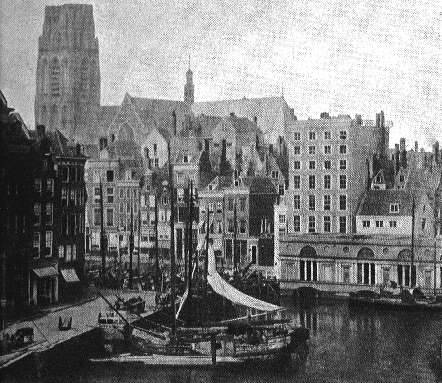 18th
century
18th
century
In the 18th century the inner city was filled with houses, industry and warehouses. There was some emerging industry (sugar, coffee, tobacco, gin). Housing was confined within the city walls where density of the population took to extremes. Outside the walls, wealthy Rotterdammers built their mansions around the villages in the area. Also forms of industry which were deemed as unsuitable for the inner city were relocated outside the walls. This was possible because Rotterdam had gained the jurisdiction in the fiefdoms around the city from noblemen who had chosen the side of the Spanish king and who had fled the country. The French occupation (1795-1813) started a period of recession.
Fast growth (1850-1940)
After the French left, Rotterdam
started to grow quite rapidly. In the German area around the river
Ruhr industrialisation took hold and because of its location
Rotterdam benefited from the trade between this area and British and
American markets. 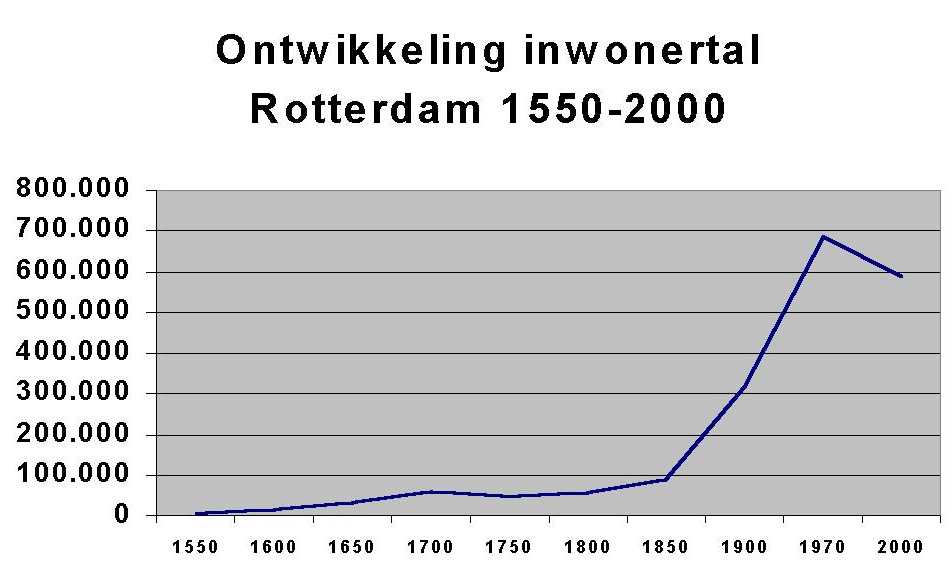 Also the exploration of Africa brought in new trade. In this
period the Inner city was being sanitised (water, drains, sewer)
and the city increased its port capacity. Employment opportunities
attracted workers from the provinces. To be able to cope with the
growth of the population Rotterdam started to develop the areas
outside the city walls for the first time. The first project was
Cool, next came Oude Westen (Old West) and Nieuwe Westen (New
West). The town of Delfshaven was incorporated in 1886, followed
by Kralingen in 1895. Of paramount importance to the development
of Rotterdam as a major port was the completion of the Nieuwe
Waterweg Canal in 1863. City growth continues on the other side of
the river on the Feijenoord peninsula. New docks are dug here
alongside with new housing estates, after the completion of the
first bridge across the river in 1878. In these developments the
businessman and city counselor Lowewijk Pincoffs played a major
role, together with his friend and banker Marten Mees. In 1879,
however he was exposed as a fraud and he fled to America.The city
took over control of the port developments under the leadership of
G.J. de Jongh, the Head of Public Works. In this period Rotterdam
takes over Amsterdam's position as main port. World War I meant a
recession for the city economy, which was not overcome until 1926.
After that the Big Depression of 1929 took its effect, also in
Rotterdam.
Also the exploration of Africa brought in new trade. In this
period the Inner city was being sanitised (water, drains, sewer)
and the city increased its port capacity. Employment opportunities
attracted workers from the provinces. To be able to cope with the
growth of the population Rotterdam started to develop the areas
outside the city walls for the first time. The first project was
Cool, next came Oude Westen (Old West) and Nieuwe Westen (New
West). The town of Delfshaven was incorporated in 1886, followed
by Kralingen in 1895. Of paramount importance to the development
of Rotterdam as a major port was the completion of the Nieuwe
Waterweg Canal in 1863. City growth continues on the other side of
the river on the Feijenoord peninsula. New docks are dug here
alongside with new housing estates, after the completion of the
first bridge across the river in 1878. In these developments the
businessman and city counselor Lowewijk Pincoffs played a major
role, together with his friend and banker Marten Mees. In 1879,
however he was exposed as a fraud and he fled to America.The city
took over control of the port developments under the leadership of
G.J. de Jongh, the Head of Public Works. In this period Rotterdam
takes over Amsterdam's position as main port. World War I meant a
recession for the city economy, which was not overcome until 1926.
After that the Big Depression of 1929 took its effect, also in
Rotterdam.
World War II and Reconstruction (1940-1975)
No event in Rotterdam history left
a deeper mark (or scar) in Rotterdam society 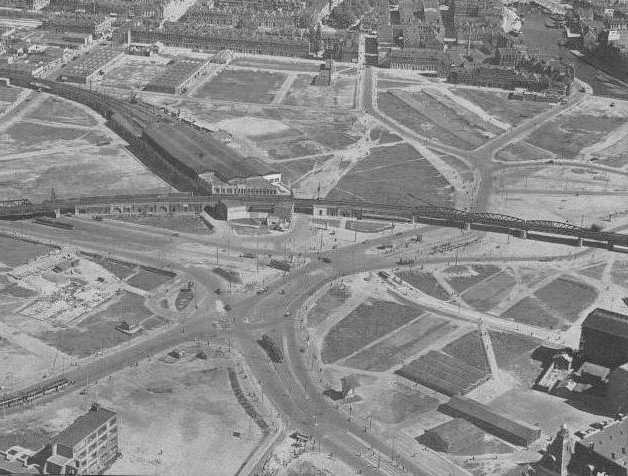 and city development than the German invasion in May 1940. 14 May
1940 the inner city and the 17th century port were completely
destroyed. Approx. 900 people died and thousands more became
homeless. Also later during the war the city suffered from
bombings, this time by allied air forces (e.g. October 1941 and
March 1943). Five years of oppression followed. In 1945 the German
troops stole just about all remaining port equipment. . Already in
1941 Witteveen, director of City Works, designed a reconstruction
plan. This plan was heavily criticised. The plan was adapted by
Van Traa into the Basic Plan of 1946 and consequently adopted by
the city council. The original street plan
and city development than the German invasion in May 1940. 14 May
1940 the inner city and the 17th century port were completely
destroyed. Approx. 900 people died and thousands more became
homeless. Also later during the war the city suffered from
bombings, this time by allied air forces (e.g. October 1941 and
March 1943). Five years of oppression followed. In 1945 the German
troops stole just about all remaining port equipment. . Already in
1941 Witteveen, director of City Works, designed a reconstruction
plan. This plan was heavily criticised. The plan was adapted by
Van Traa into the Basic Plan of 1946 and consequently adopted by
the city council. The original street plan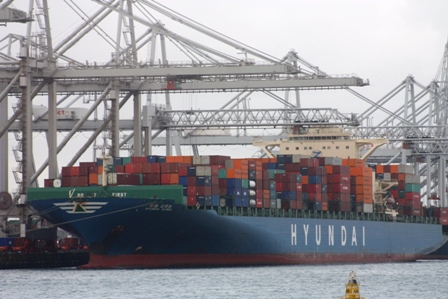 was abandoned and the city centre was being connected by wide
avenues. The Basic Plan was functional. Different city functions
were grouped in separate areas: shopping, banking, housing,
leisure. Especially the modernist or functionalist architects were
very influential in the post-war reconstruction. In the centre 50%
of the housing capacity disappeared. New housing estates were
built on the outskirts.
was abandoned and the city centre was being connected by wide
avenues. The Basic Plan was functional. Different city functions
were grouped in separate areas: shopping, banking, housing,
leisure. Especially the modernist or functionalist architects were
very influential in the post-war reconstruction. In the centre 50%
of the housing capacity disappeared. New housing estates were
built on the outskirts.
The port developed in a westerly direction towards the sea. Bigger and deeper ports were being dug closer to the shoreline. (Petrochemical industries became increasingly important.
Recent past and present
By the end of the 1970s and early 1980s
the Basic Plan had been completed for some time. A new city had
emerged, but the rigid separation of functions and the strict
functionalist architecture had resulted in a somewhat cold and quiet
city. In reaction to that the remaining spaces were filled 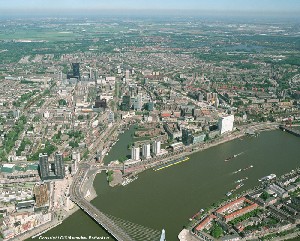 with new adventurous, but small scale housing developments. The old
19th century housing areas were redeveloped. This era also shows
mass migration from inner city areas to the suburbs. The vacancies
left by the Rotterdammers are taken by immigrants. In the late 1980s
and 1990s the city government decided to revive the city center with
high rise offices and apartments, thus giving the city a
metropolitan look. The most recent projects are the Erasmus Bridge
and the Kop van Zuid. The latter being a redevelopment of disused
inner city docklands.
with new adventurous, but small scale housing developments. The old
19th century housing areas were redeveloped. This era also shows
mass migration from inner city areas to the suburbs. The vacancies
left by the Rotterdammers are taken by immigrants. In the late 1980s
and 1990s the city government decided to revive the city center with
high rise offices and apartments, thus giving the city a
metropolitan look. The most recent projects are the Erasmus Bridge
and the Kop van Zuid. The latter being a redevelopment of disused
inner city docklands.
The rapid economic growth between 1965 and 1973 leads to great demand for (cheap) labour. This causes a first emigration wave of workers from the Mediterranean area. Around 1975 a large number of migrants from the former Dutch colony of Surinam follows. Recent economic growth in the 1990s again leads to even more immigration. Meanwhile around 40% of the Rotterdam population is of foreign extraction. Apart from problems regarding integration (or lack thereof) this development resulted in a cosmopolitan atmosphere, with a huge diversity in the cultural, culinary and religious field.
Rotterdam's open and cosmopolitan
character also has a down side. Big differences in drugs policies
between the Netherlands and the neighbouring countries has made
Rotterdam a popular destination for especially French and Belgian
"drug tourists". This form of "tourism" is concentrated in the areas
that already have a weak social structure. In spite of substantial
progress in fighting the problem, the
solution for the inconvenience to the inhabitants caused by this
phenomenon is not in sight yet.
In the field of culture a lot of
progress has been made in recent years. Rotterdam has got quite a
few leading cultural events (film festival, poetry international,
Dunya, Caribbean Carnival) and has built and is still building new
cultural facilities (theatres, museums, etc). In 2001 Rotterdam
was the European Capital of Culture. Also in sports Rotterdam has
conquered its place on the map: the Rotterdam Marathon is one of
the leading and fastest in the 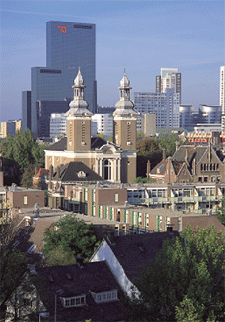 world. In 2000 the finals of the European Football Championships
were played in the Feyenoord Stadium. In 2010 the Tour de France
had its Grand Depart in Rotterdam. Plans are made for a new
football stadium .
world. In 2000 the finals of the European Football Championships
were played in the Feyenoord Stadium. In 2010 the Tour de France
had its Grand Depart in Rotterdam. Plans are made for a new
football stadium .
In 2002 sentiments of dissatisfaction, that have been slumbering among voters get a political dimension when Rotterdam based former social scientist, columnist and business consultant Pim Fortuyn puts himself at the vanguard of it. The debate is about the lack of integration among immigrants, (street) crime and the closed culture of the politics and bureaucracy. In very short time Fortuyn gathers wide spread support in the run up to local elections of 2002. This results in 16 out of 45 seats on the city council for his Leefbaar Rotterdam party and half of the seats on the city executive. His final goal is a role in national politics in which he raises high hopes for his national party, that carries his name. On the May 6th, however, 9 days before the national elections he is murdered, while leaving a radio studio in Hilversum. This dramatic event sends a shockwave through Rotterdam and Dutch society. At the national election his party LPF gets 17% of the votes cast. An unprecedented election result for a new party giving it 26 seats in the 150 seat parliament. LPF proves to be an instable force in politics and is finally dissolved in 2008.
The city government under Mayor Mr. Opstelten (VVD) makes public safety its main priority. At the request of the city of Rotterdam National Parliament passes the so called Rotterdam Act, which enables city governments to limit the influx of people who fail to meet certain income requirements into districts where the proportion of low income inhabitants is already high.
At the 2006 council elections the social democratic PvdA makes a sensational comeback and becomes the largest party. Fortuyn's Leefbaar Rotterdam party runs second but refuses a coalition with PvdA. PvdA then forms a new city executive with the decimated Christian Democrats and right-wing Liberals and the Green party. The new government basicalliy promises to continue the policies of the previous executive on public safety, but with more sensitivity to social issues. In 2009 Mayor Opstelten retires and is replaced by Mr Ahmet Aboutaleb (PvdA). A select committee of the city council nominated him as the first Mayor of Moroccan descent in the Netherlands and the first in a European major city. Part of the Leefbaar faction on the council opposed his nomination.
The poorly carried out 2010 council elections resulted in an equal number of seats for PvdA and Leefbaar. After a recount PvdA held on to its position of largest party and formed a new executive with social liberal D66, conservative liberal VVD and the Christian Democrats. During the campaign PvdA had ruled out a coalition with Leefbaar, partly because of this party's attitude towards the Mayor. With time Aboutaleb won confidence as Mayor within all parties on the City Counsel and among the population. His record on public safety, the prime and sole responsibility of a Dutch Mayor, is good.
The financial crisis of 2008 and the subsequent European debt crisis starts to bite and making dents in the city budget around 2012. Also the regional economy is affected by the negative economical national and international trends. The national government is making cuts in its funding of local government and the city expenditures on benefits and wellfare go up because of rising unemployment.